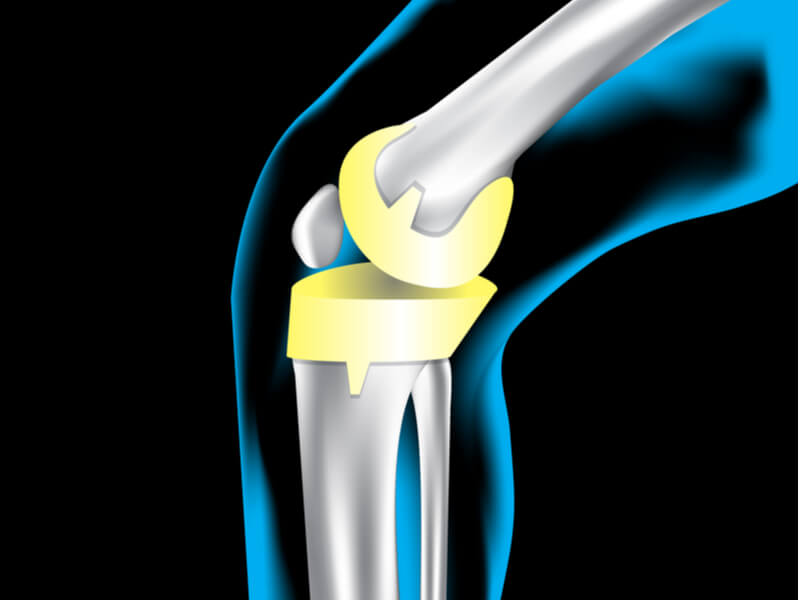
Artificial joint surgery is a procedure in which the surface of a joint that has been damaged and deformed due to osteoarthritis, rheumatoid arthritis, or trauma is removed and replaced with an artificial joint
It is performed on various joints such as shoulders, elbows, fingers, knees, and feet
Among them, total knee replacement is a surgery to replace the knee joint with an artificial jointTotal knee replacementWe will explain about this
table of contents
■What is an artificial joint?
Artificial joints are made up of three parts: the femur, tibia, and patella, which allow for the smooth movement of a natural joint
The bodies of the femur and tibia are made of metal, but the top surface of the tibia and the surface of the patella are made of durable, hard polyethylene, which acts as a cartilage substitute
Attempts to create artificial joints began in the late 1800s using materials such as celluloid, silver, zinc, ivory, and joint capsules, and full-scale clinical application of metal artificial joints began in the 1950s
The type of artificial joint used depends on the severity of the injury
If the damage is relatively minor, only the surface of the bone can be removed and replaced, but if the knee joint is severely damaged, complex knee joint components will be required to replace the worn bone
When artificial joints were first developed, they would break after a short period of time, but now they are made of long-lasting materials such as metal, polyethylene, and ceramic, making them suitable for long-term use
■Procedure for total knee replacement
Knee replacement surgery involves removing the damaged bone from the diseased knee joint and then fixing in a replacement artificial joint
In contrast to total knee replacement, in which the entire knee joint is replaced with an artificial joint, partial knee replacement replaces only the damaged side of the knee joint with an artificial joint. It is intended for people in the early stages of knee damage, such as when only the cartilage on one side of the joint is worn down and the other side is less worn down
Partial replacement surgery uses an artificial joint that is about half the size of a regular artificial joint, so generally there is less skin incision and less bone removal
Not all patients are suitable,In recent years, minimally invasive surgery has also been performed, which aims to minimize the scarring and reduce the burden on the patient's body
Surgical techniques are also gradually improving, and we are striving to make surgery more patient-friendly by using methods such as preserving muscles without cutting them
■ Guidelines for indications for total knee replacement surgery
Patients who are candidates for total knee replacement surgery are those with osteoarthritis or rheumatoid arthritis that have caused joint destruction and instability, or who have contractures that interfere with their daily lives
In the case of partial replacement, the following conditions must also be considered:
- Able to fully extend knees
・Mild bow legs or knock-knees
Pain only on the inside or outside of the knee
- Not rheumatoid arthritis
Not severely obese
There is no abnormality in the knee ligaments
As it has become possible to use artificial joints for a long period of time, their use has expanded to include not only the elderly but also relatively younger generations
Partial knee replacement surgery may not be possible depending on the patient's condition and symptoms. If you wish to undergo partial knee replacement surgery, you should thoroughly discuss the indications, effects, and risks with your doctor
■Statistical data for total knee replacement surgery
Total knee replacement surgery has been performed in Japan for over 40 years
It has become a common treatment in orthopedics, and the number of surgeries is increasing year by year, currently reaching more than 90,000 cases per year. In addition, a stable success rate of over 90% has been reported even with long-term use for more than 15 years after surgery, and the number of surgeries is steadily increasing in Japan as well
Additionally, according to data published by the Ministry of Health, Labor and Welfare, the average age of patients undergoing total knee replacement surgery is 75 years old, meaning that the surgery is being performed on relatively elderly patients
*Ministry of Health, Labor and Welfare's 4th NDB Open Data (database of information on medical receipts and specific health checkups, etc.)
Medical treatment from April 2017 to March 2018
■Effects and complications of total knee replacement
Total knee replacement is a surgical procedure that restores joint function by removing damaged parts of the knee joint and replacing the severely damaged joint surface with artificial materials such as metal or polyethylene
Artificial joint replacement can be expected to reduce knee pain and improve joint function
In addition, pain disappears soon after surgery, allowing patients to walk more smoothly. Improvements in muscle strength and movement speed are observed, dramatically improving quality of life. The range of joint motion is also improved, allowing patients to regain a range of movement that does not interfere with daily life
Postoperative complications such as infection, deep vein thrombosis, pulmonary embolism, and fractures may occur, but the procedure is generally safe and highly effective
Please consult with your doctor and enjoy the benefits of knee replacement surgery
*In addition to the article, there is a statement from the Japan Society of Artificial Joint Research (What is an artificial joint? | Japan Society of Artificial Joints (jsra.info)) is used as a reference
Supervision: Dr. Yasushi Tsuda
